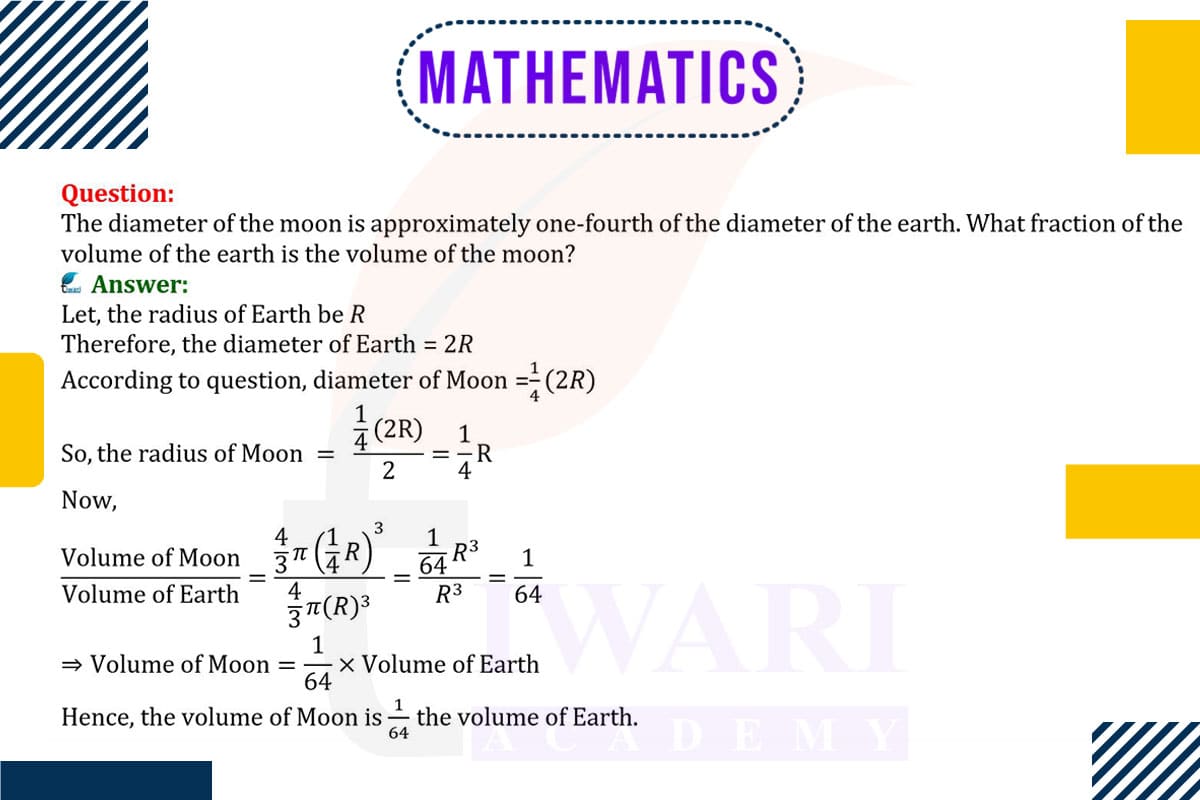To compare the volume of the Moon to that of the Earth, we use the formula for the volume of a sphere, V = (4/3)πr³, where r is the radius. The volume of a sphere is directly proportional to the cube of its radius.
Given that the diameter of the Moon is approximately one-fourth that of the Earth, its radius is also one-fourth that of the Earth. Therefore, the volume of the Moon is (1/4)³ or 1/64 of the volume of the Earth. This means the Moon’s volume is approximately 1/64th that of the Earth, illustrating how a small change in radius leads to a significant change in volume due to the cubic relationship.

Let’s discuss in detail
Comparative Planetary Volumes
Understanding the comparative sizes of celestial bodies, such as the Earth and the Moon, is a fundamental aspect of astronomy and planetary science. The volume of a planet or a moon is a key characteristic that helps scientists understand various aspects of these celestial bodies, including their formation, structure, and potential for hosting life. The comparison between the Earth and the Moon’s volumes is particularly interesting due to their close relationship and significant size difference.
The Significance of Diameter in Volume Calculation
The diameter of a celestial body is directly related to its volume. The volume of a sphere, which is a good approximation for many celestial bodies, including the Earth and the Moon, is calculated using the formula V = (4/3)πr³, where r is the radius. The radius is half the diameter, so any change in the diameter significantly impacts the volume. This relationship is crucial for understanding how the size of the Moon compares to that of the Earth.
The Moon’s Diameter Relative to Earth
The Moon’s diameter is approximately one-fourth that of the Earth. This means that if the Earth’s diameter is considered as a reference, the Moon’s diameter is significantly smaller. This ratio is an important factor in calculating the comparative volumes of these two celestial bodies. The smaller diameter of the Moon implies a much smaller volume compared to the Earth, despite being the Earth’s closest celestial neighbor.
Calculating the Moon’s Volume
To calculate the Moon’s volume relative to the Earth, we use the fact that the volume of a sphere is proportional to the cube of its radius. Since the Moon’s diameter (and hence its radius) is one-fourth that of the Earth, its volume is (1/4)³ of the Earth’s volume. This calculation is based on the cubic relationship between the radius and volume of a sphere.
The Fraction of the Earth’s Volume Represented by the Moon
The calculation (1/4)³ simplifies to 1/64. Therefore, the volume of the Moon is 1/64th the volume of the Earth. This significant difference in volume highlights the vast size disparity between the Earth and its satellite. Despite the Moon’s prominent appearance in the Earth’s sky, it is substantially smaller in volume, which has implications for its gravitational influence, surface area, and overall physical characteristics.
Understanding Celestial Size and Scale
In conclusion, the comparison of the Moon’s volume to that of the Earth illustrates the vast differences in scale within our solar system. This 1/64th ratio underscores the importance of understanding geometric principles when studying celestial bodies. Such comparisons are not only fascinating but also crucial for astronomers and scientists in understanding the dynamics of planetary systems, the formation of moons, and the comparative analysis of celestial bodies. The study of these ratios enhances our comprehension of the universe’s vastness and the relative scale of its constituents.
Discuss this question in detail or visit to Class 9 Maths Chapter 11 for all questions.
Questions of 9th Maths Exercise 11.4 in Detail

